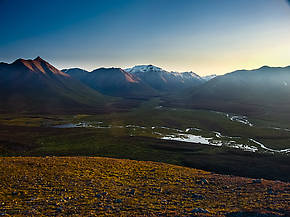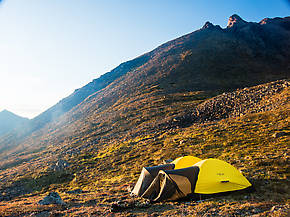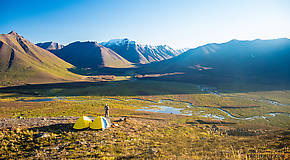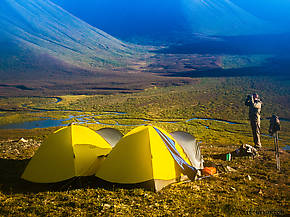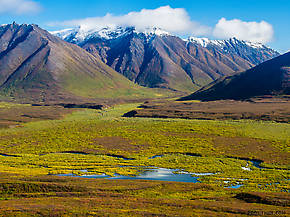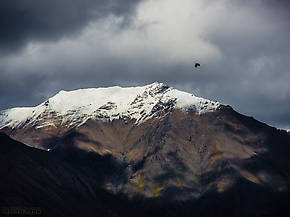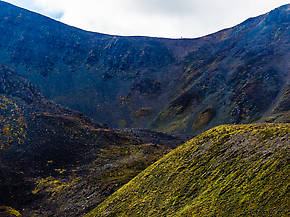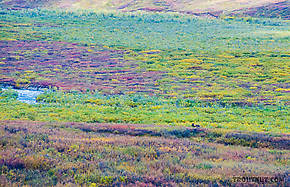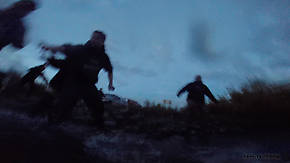We filled our empty backpacks with caribou, splitting the whole animal between the two of us for a single, mile-long, 715 vertical foot descent to the river. My dad carried around 80 pounds and I took about 120 pounds in a Kifaru pack suited to the load. Climbing down a steep slope with heavy weight is in many ways harder than climbing up, because it is easy to step downhill with too much force onto unstable ground and have the loose, gravelly soil give way. Each footfall must be placed with deliberate gentleness. Impatience risks injury.
We patiently descended the hill and then followed a disjoint mix of well-trodden game trails through the lowland brush, arriving at 10:45 at the river. A bit of easy wading put us on a broad gravel island with a small stand of grass and willows where we could store the meat out of the sun while we went back uphill to retrieve camp.

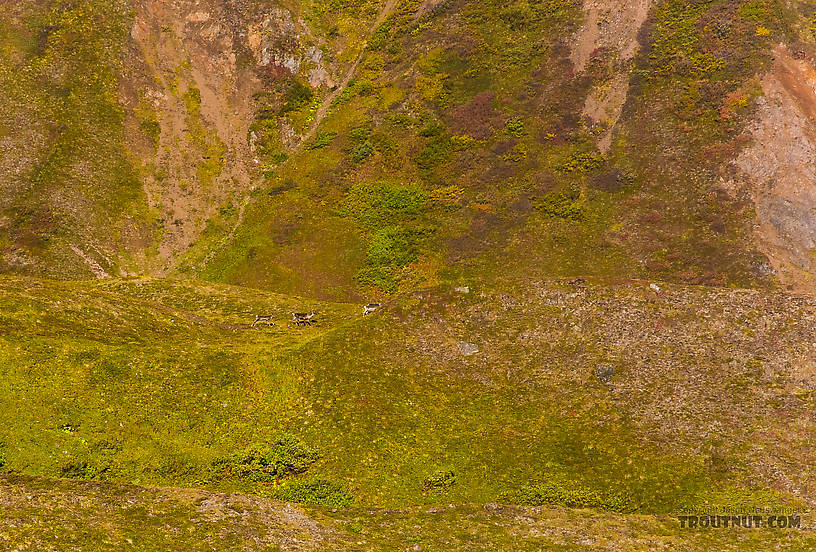
Just as we finished caching the meat, my dad shouted a whisper, "Jason, look!" A hundred yards upstream, a wolf was swimming across the river--probably the same animal we watched chasing caribou from camp the day before. I had my rifle by my side and an easy shot, had I wanted to take it, in this designated predator control area. Predator hunting is important to Alaskan game management, because wolves and bears kill about as many moose and caribou as human hunters do, and our meticulous management of ungulate herds is almost moot without some regulation of the other half of the equation. Despite recognizing this necessity, I normally see wolves as too great and rare a symbol of wilderness, and too superficially similar to my pet husky, to place one in the crosshairs myself. But this wolf posed an eminent threat to my hard-won caribou meat. The temptation to add a unique hide to my wall flickered more brightly than ever before. I ran at the wolf as it disappeared into the streamside willows, shouting at the top of my lungs, "Hey, wolf! Get out of here! Hey, wolf!" Seeing no response, I sent a loud rifle shot into a vacant patch of dirt, and the wolf bounded away through the willows.
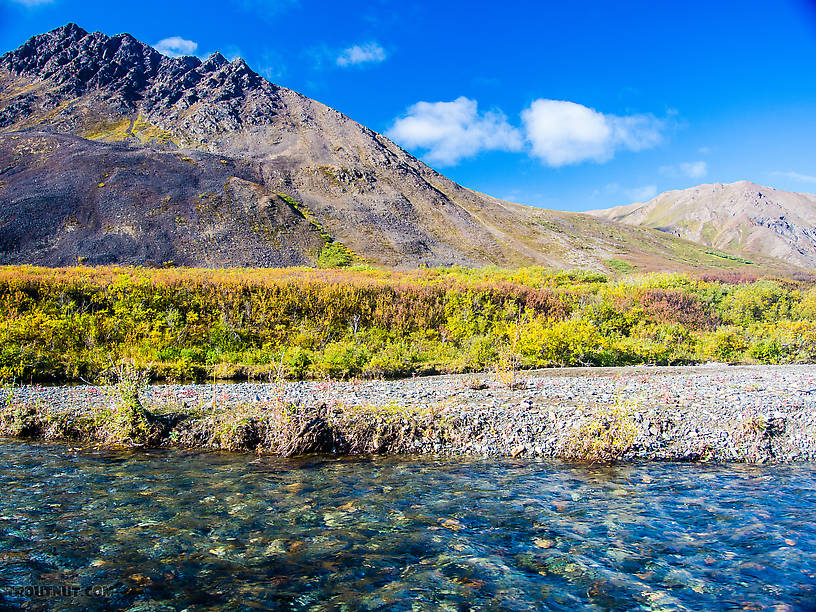
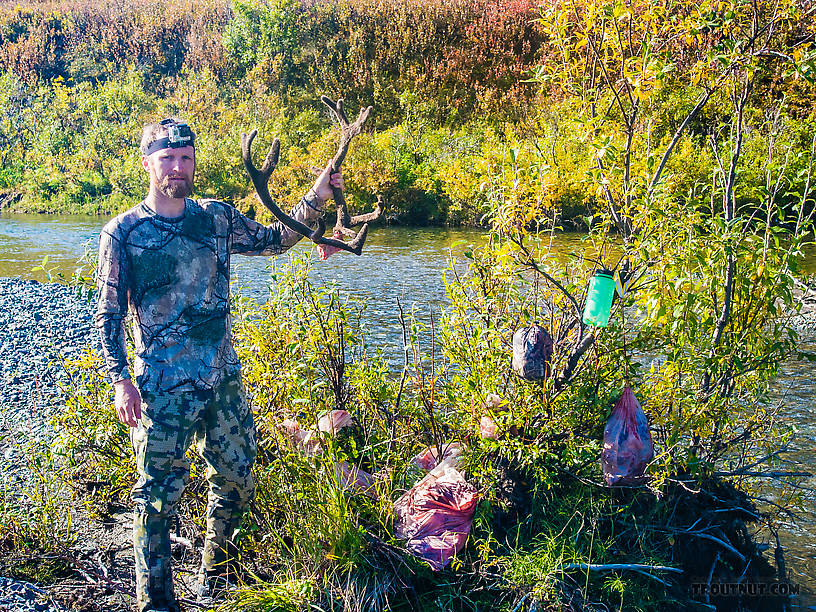
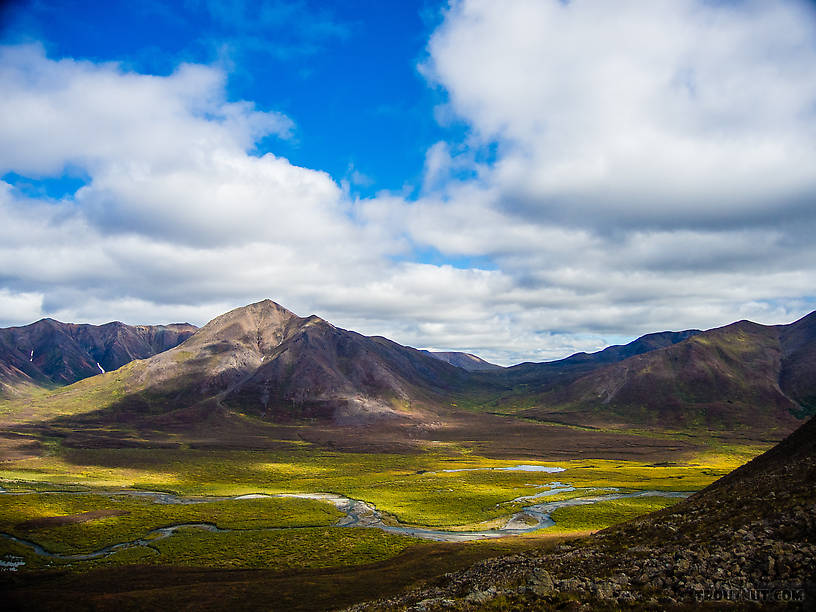
The meat was safe, for now, but we had a new urgency to climb back up the mountain, break camp, and return to the river before the wolf recovered its courage. This took until about 3:00 pm. Along the way we encountered a few scattered cow and calf caribou and spotted two distant bull moose, both sublegal but impressive nonetheless. An eagle flew around below us, and a caribou appeared atop The "Pass."
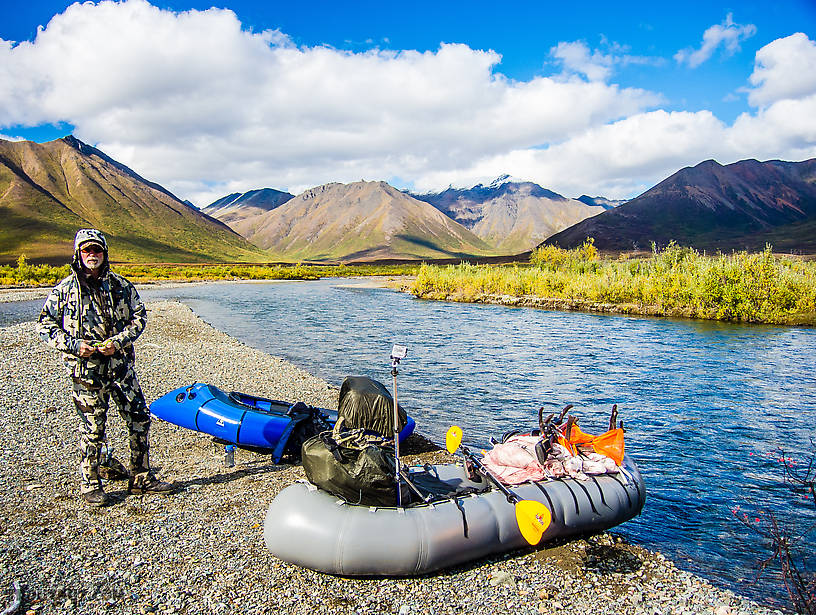
We had our rafts blown up and loaded by 4:30. While preparing to leave we encountered another pair of hunters who had just walked in by a different route with similar plans; we swapped information about the moose and caribou for their knowledge of floating the river in past years. They warned of one place to turn up a shallow channel and drag the rafts or else find ourselves paddling through a labyrinth of beaver ponds, and they cautioned us about the rapids ahead--not to be afraid, they said, but pay attention.
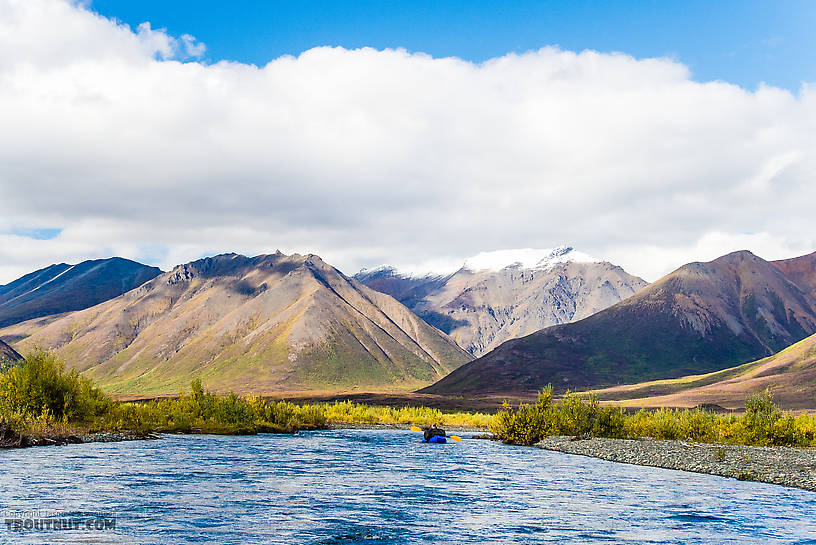
The beginning of the float was a relaxing glide through the terrain we worked so hard to pass on the way in. We enjoyed million-dollar views of the mountains, a small bull moose, and occasional caribou in the streamside brush or skylined on distant ridges. We bypassed a massive complex of beaver ponds by navigating the westernmost channels as suggested. Toward the second half of the float, the gradient picked up and rapids became more frequent. Laden with my heavy pack and caribou meat, my small raft felt more tippy and handled more sluggishly than it has in the past, but I had little trouble threading it through various Class I boulder gardens.
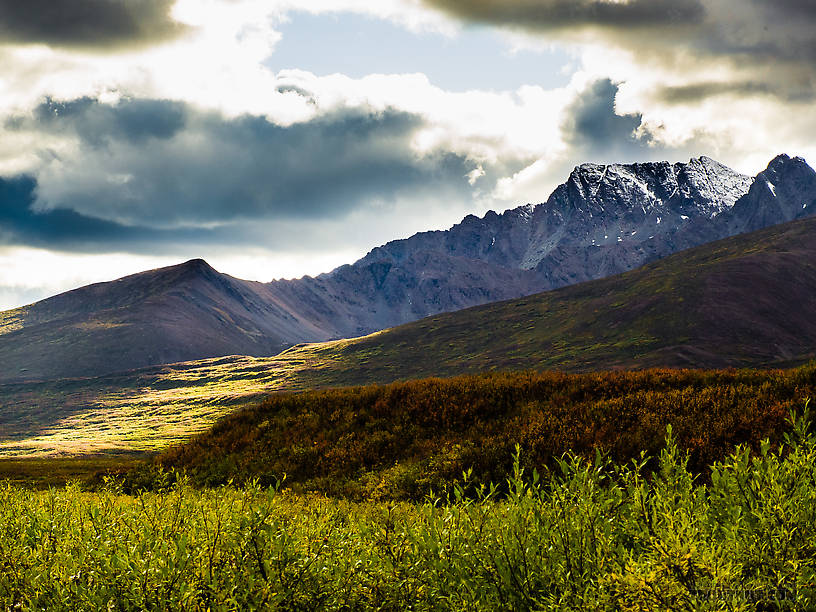
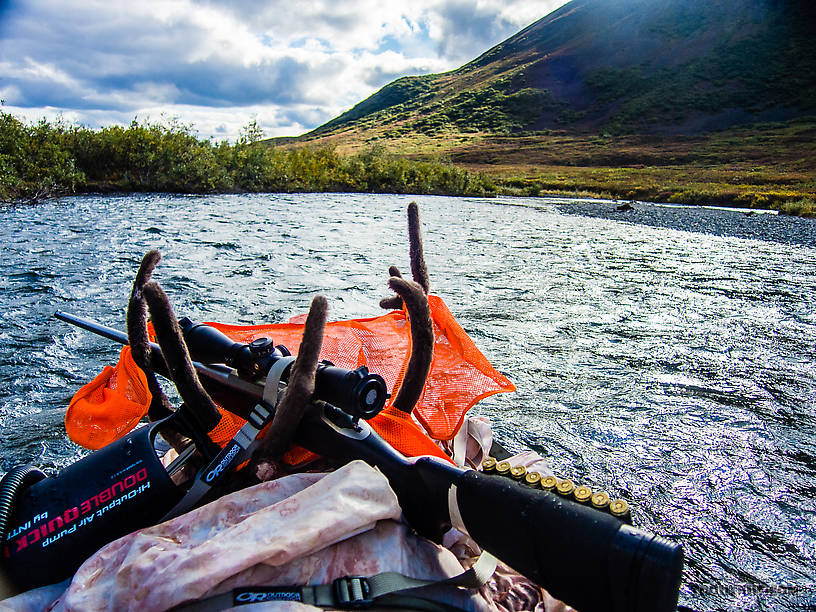
We'd been warned of a single Class II somewhere on this float, and as we entered some progressively trickier Class I rapids (which would called Class II or more in many places) we kept wondering, "Was that it?" The answer was always no. When we reached it, we didn't have to ask. Toward the end of a Class I stretch the river got noticeably steeper leading into several large rocks and tall standing waves going straight into a blind corner (WGS84 coordinates: N63° 04.348' W146° 56.652'). This would be a solid Class II for a nimble boat, but with our loads and in this environment, it was more than that.
Just before the worst water I pulled up on the left bank to scout around the blind corner. My dad similarly stopped fifty yards above me, and joined me to scout. We struggled through a barely penetrable tangle of willows, growing more nervous about the biggest water was we walked right by it. Our apprehension was compounded by the setting sun and the fact that we were still a few miles of unknown water above the road. We saw that the river opened up around the blind corner, and there was space to cross over to a shallow rock bar on the right bank and line rafts past the next corner--a fast, sharply turning chute in which a canoe was wrapped around a giant boulder like a discarded banana peel. Dad wanted to cross the river to the other bank and line his raft down past the worst of the rapids, but I was too far downstream to cross over. I spied a line I could take between the boulders and through the tallest wavetrains near the left bank, and I had few other options. Dad decided to take that route, too, to save precious time. He would try to slow and stabilize himself by hugging the bank and grabbing willow branches. I should have known not to support that plan, but my head was too full of other worries.
When he signaled that he was ready to go, I pushed off. I held my line through the boulders easily enough; in seconds I was beached at the planned point on the next bend. I sat and watched upstream for my dad in his raft. Instead, I saw his water bottle. Then his backpack lid. No raft. No dad. Uh-oh.
I sprinted up around the bend on the right bank, waving my paddle in the air so he could see me and I could use it to pull him out of the river if necessary. I found him near where he started, half submerged in shallow but fast water, desperately clinging to his upside-down raft and attached backpack with one hand, and to bankside willows with the other. His plan to slowly control his descent by grabbing the willows had gone horribly wrong, and they caught the raft and flipped him over backward. For minutes that seemed like hours, I watched helplessly from across the uncrossable rapids as he struggled against the current to try to turn the raft upright. The current was too strong. He finally looped one of the lines of the raft onto a willow branch to free up both hands, but the branch broke and suddenly the raft and his backpack were floating free, upside down, through the worst of the rapids.
I yelled that I would try to catch the raft and wait for him, and sprinted downstream through the brush to my own raft. Dad's raft was out of sight by the time I jumped in mine. I paddled fast and was relieved to find his raft, pack still attached, beached on an island a bend or two downstream. About ten minutes later, he arrived on the bank, soaking wet but warm from exertion, and was ready to continue downstream. His soaking wet pack, weighing 60+ pounds when dry, was too much for the Alpacka raft, so we cannibalized a couple of seemingly superfluous straps holding my meat down (several were still secure) and secured his pack atop mine in the back of my raft.
Our rafts were slower than ever with our gear soaking wet and water sloshing in the bottom, but we had no more incidents in several Class I boulder dodgers downstream. I've never been so pleased to see vehicles up on the road as I was when we reached the last mile of the float, where the river parallels the road. Finally we rounded the last corner amidst another boulder garden, and the bridge and take-out came into view.
Our planned take-out was a smooth eddy pool created where Little Clearwater Creek enters from the right bank and deflects the water from the main river at a right angle. It might have been best to enter the calm part of the eddy from the side, but my raft wasn't nimble enough for that maneuver. I elected to power right through the top of the eddy, where Little Clearwater Creek blasts a jet of water perpendicular to the main river. Within a stone's throw of the takeout, I felt the jet slam into the deeply drafting front left side of my raft, pushing it downward, giving it more surface on which to push even harder. The inertia of my top-heavy craft fed the roll. I tried to counter it with my weight and my paddle, but within two seconds the raft was upside-down and I was underwater beneath it. My feet could not touch bottom, and only the top of my head (with a running GoPro) remained above water.

The water temperature was in the thirties, but I did not notice the cold. I had taken a good breath on the way down, so before I came up for air I took my time to formulate a plan. It later turned out "took my time" meant "about one second," but I was experiencing events in Matrix-like slow motion. Step 1: Grip the raft! I had my left hand on the tubes, and guided my right hand to a death grip on the sturdy nylon carrying strap on the stern. Step 2: Come up for air. Done. Step 3: Find my footing. This happened quickly as the pool shallowed out, but there it entered a powerful rapids. Step 4: Get to shore. My feet gripped the rocks for a moment before the powerful pull of the water on the boat and my body dislodged the rocks, so I was dumped again in the water and scrambling for more footing. Each time I gained a foothold I pulled toward shore, and each time, the rocks gave way. For forty long seconds I struggled by myself against the failing bottom.
Behind me and out of sight, my dad floated effortlessly over the cross-current in his unburdened Alpacka, which he beached and sprinted to help me. At the same time, several campers on shore--a family of hunters from Valdez--heard the commotion and came running. They all converged on me as I neared shore and grabbed on to various parts of my raft, my gear, and me. My dad and some of the others jumped into the river to help hoist everything to shore, which was barely possible even with 4+ people.
I had brought more straps than I thought necessary, and used all of them, to my gear on my raft, and I thought I was being paranoid when I threaded the straps through every loop I could find on everything I was tying down. This seeming excess of caution probably saved me thousands of dollars, as we recovered all the gear in both backpacks, my gun, and most of the caribou meat. I was very grateful to have recovered so much, when a brief failure of my grip during that minute of rock-scrambling could have lost it all. However, I was upset about part of the meat washing away (we spent (Spent: The wing position of many aquatic insects when they fall on the water after mating. The wings of both sides lay flat on the water. The word may be used to describe insects with their wings in that position, as well as the position itself.) a long time and got soaked trying to find it the next morning, before concluding it was probably half-way to the ocean already). Just as gut-wrenching, I could not find the little drybag containing my camera with all the photos from this trip. It had been threaded onto a pack strap that came unclipped during the fiasco. We thought it was lost until we got back to Fairbanks and discovered it, floating loose, tangled up in the folds of my backpack's rain cover. A close call!
We were very lucky to meet those campers from Valdez at a time of great need. My dad warmed himself by their roaring campfire while I changed into clothes from my drybag in their RV. They gave me a ride to my car, during which I noticed I was beginning to feel deeply chilled from the cold and had trouble speaking without stuttering, a sign of stage 1 hypothermia, but I was on the way to warming up so I wasn't really worried. I drove to the Alpine Creek Lodge where the co-owner, Jen, found a room for us and offered to stay up late and get us a hot meal. Their hospitality is always as good as it gets. I drove back to retrieve dad and our gear, and we ended the day's adventures in a warm bed in the lodge.



